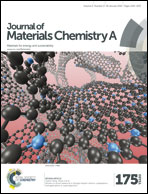MIL-91(Ti), a small pore metal–organic framework which fulfils several criteria: an upscaled green synthesis, excellent water stability, high CO2 selectivity and fast CO2 transport†
Abstract
A multidisciplinary approach combining advanced experimental and modelling tools was undertaken to characterize the promises of a small-pore type Ti-based metal–organic framework, MIL-91(Ti) for CO2 capture. This material was prepared using two synthesis strategies, i.e. under hydrothermal conditions and under reflux, and its single component adsorption behaviour with respect to CO2, CH4 and N2 was first revealed by gravimetry measurements. This hydrophilic and highly water stable MOF is characterized by a relatively high CO2 adsorption enthalpy. Molecular simulations combined with in situ powder X-ray diffraction evidenced that this is due to the combined interaction of this probe with N–H and P–O groups in the phosphonate linker. High CO2 selectivities in the presence of either N2 or CH4 were also predicted and confirmed by co-adsorption measurements. The possibility to prepare this sample under reflux represents an environmentally friendly route which can easily be upscaled. This green synthesis route, excellent water stability, high selectivities and relatively fast transport kinetics of CO2 are significant points rendering this sample of utmost interest for CO2 capture.


 Please wait while we load your content...
Please wait while we load your content...